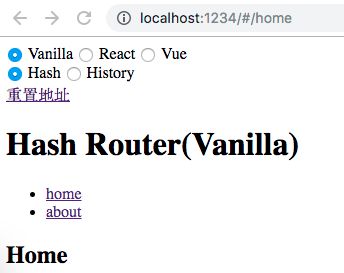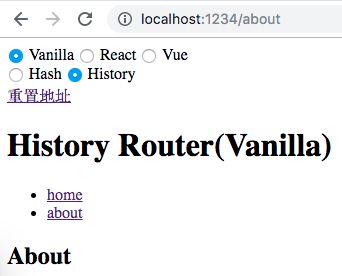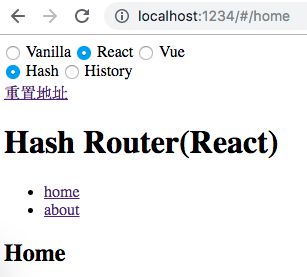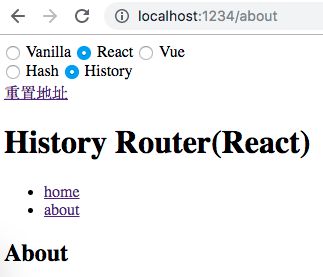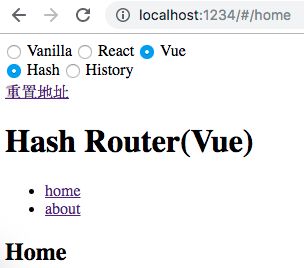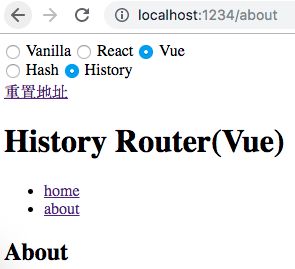在单页应用如此流行的今天,曾经令人惊叹的前端路由已经成为各大框架的基础标配,每个框架都提供了强大的路由功能,导致路由实现变的复杂。想要搞懂路由内部实现还是有些困难的,但是如果只想了解路由实现基本原理还是比较简单的。本文针对前端路由主流的实现方式 hash 和 history,提供了原生JS/React/Vue 共计六个版本供参考,每个版本的实现代码约 25~40 行左右(含空行)。
什么是前端路由?
路由的概念来源于服务端,在服务端中路由描述的是 URL 与处理函数之间的映射关系。
在 Web 前端单页应用 SPA(Single Page Application)中,路由描述的是 URL 与 UI 之间的映射关系,这种映射是单向的,即 URL 变化引起 UI 更新(无需刷新页面)。
如何实现前端路由?
要实现前端路由,需要解决两个核心问题:
如何改变 URL 却不引起页面刷新?如何检测 URL 变化了?
下面分别使用 hash 和 history 两种实现方式回答上面的两个核心问题。
hash 实现
- hash 是 URL 中 hash (
#) 及后面的那部分,常用作锚点在页面内进行导航,改变 URL 中的 hash 部分不会引起页面刷新 - 通过 hashchange 事件监听 URL 的变化,改变 URL 的方式只有这几种:通过浏览器前进后退改变 URL、通过
标签改变 URL、通过window.location改变URL,这几种情况改变 URL 都会触发 hashchange 事件
history 实现
- history 提供了 pushState 和 replaceState 两个方法,这两个方法改变 URL 的 path 部分不会引起页面刷新
- history 提供类似 hashchange 事件的 popstate 事件,但 popstate 事件有些不同:通过浏览器前进后退改变 URL 时会触发 popstate 事件,通过
pushState/replaceState或标签改变 URL 不会触发 popstate 事件。好在我们可以拦截 pushState/replaceState的调用和标签的点击事件来检测 URL 变化,所以监听 URL 变化可以实现,只是没有 hashchange 那么方便。
原生JS版前端路由实现
基于上节讨论的两种实现方式,分别实现 hash 版本和 history 版本的路由,示例使用原生 HTML/JS 实现,不依赖任何框架。
基于 hash 实现
运行效果:
HTML 部分:
JavaScript 部分:
// 页面加载完不会触发 hashchange,这里主动触发一次 hashchange 事件
window.addEventListener('DOMContentLoaded', onLoad)
// 监听路由变化
window.addEventListener('hashchange', onHashChange)
// 路由视图
var routerView = null
function onLoad () {
routerView = document.querySelector('#routeView')
onHashChange()
}
// 路由变化时,根据路由渲染对应 UI
function onHashChange () {
switch (location.hash) {
case '#/home':
routerView.innerHTML = 'Home'
return
case '#/about':
routerView.innerHTML = 'About'
return
default:
return
}
}
基于 history 实现
运行效果:
HTML 部分:
JavaScript 部分:
// 页面加载完不会触发 hashchange,这里主动触发一次 hashchange 事件
window.addEventListener('DOMContentLoaded', onLoad)
// 监听路由变化
window.addEventListener('popstate', onPopState)
// 路由视图
var routerView = null
function onLoad () {
routerView = document.querySelector('#routeView')
onPopState()
href=""> // 拦截 标签点击事件默认行为, 点击时使用 pushState 修改 URL并更新手动 UI,从而实现点击链接更新 URL 和 UI 的效果。
var linkList = document.querySelectorAll('a[href]')
linkList.forEach(el => el.addEventListener('click', function (e) {
e.preventDefault()
history.pushState(null, '', el.getAttribute('href'))
onPopState()
}))
}
// 路由变化时,根据路由渲染对应 UI
function onPopState () {
switch (location.pathname) {
case '/home':
routerView.innerHTML = 'Home'
return
case '/about':
routerView.innerHTML = 'About'
return
default:
return
}
}
React 版前端路由实现
基于 hash 实现
运行效果:
使用方式和 react-router 类似:
- home
- about
Home
} />About
} />
BrowserRouter 实现
export default class BrowserRouter extends React.Component {
state = {
currentPath: utils.extractHashPath(window.location.href)
};
onHashChange = e => {
const currentPath = utils.extractHashPath(e.newURL);
console.log("onHashChange:", currentPath);
this.setState({ currentPath });
};
componentDidMount() {
window.addEventListener("hashchange", this.onHashChange);
}
componentWillUnmount() {
window.removeEventListener("hashchange", this.onHashChange);
}
render() {
return (
{this.props.children}
);
}
}
Route 实现
export default ({ path, render }) => (
{({currentPath}) => currentPath === path && render()}
);
Link 实现
基于 history 实现
运行效果:
使用方式和 react-router 类似:
- home
- about
Home
} />About
} />
HistoryRouter 实现
export default class HistoryRouter extends React.Component {
state = {
currentPath: utils.extractUrlPath(window.location.href)
};
onPopState = e => {
const currentPath = utils.extractUrlPath(window.location.href);
console.log("onPopState:", currentPath);
this.setState({ currentPath });
};
componentDidMount() {
window.addEventListener("popstate", this.onPopState);
}
componentWillUnmount() {
window.removeEventListener("popstate", this.onPopState);
}
render() {
return (
{this.props.children}
);
}
}
Route 实现
export default ({ path, render }) => (
{({currentPath}) => currentPath === path && render()}
);
Link 实现
export default ({ to, ...props }) => (
{({ onPopState }) => (
{
e.preventDefault();
window.history.pushState(null, "", to);
onPopState();
}}
/>
)}
);
Vue 版本前端路由实现
基于 hash 实现
运行效果:
使用方式和 vue-router 类似(vue-router 通过插件机制注入路由,但是这样隐藏了实现细节,为了保持代码直观,这里没有使用 Vue 插件封装):
home about
Home
'
},
'/about': {
template: 'About
'
}
}
const app = new Vue({
el: '.vue.hash',
components: {
'router-view': RouterView,
'router-link': RouterLink
},
beforeCreate () {
this.$routes = routes
}
})
router-view 实现:
router-link 实现:
基于 history 实现
运行效果:
使用方式和 vue-router 类似:
home about
Home
'
},
'/about': {
template: 'About
'
}
}
const app = new Vue({
el: '.vue.history',
components: {
'router-view': RouterView,
'router-link': RouterLink
},
created () {
this.$routes = routes
this.boundPopState = this.onPopState.bind(this)
},
beforeMount () {
window.addEventListener('popstate', this.boundPopState)
},
beforeDestroy () {
window.removeEventListener('popstate', this.boundPopState)
},
methods: {
onPopState (...args) {
this.$emit('popstate', ...args)
}
}
})
router-view 实现:
router-link 实现:
小结
前端路由的核心实现原理很简单,但是结合具体框架后,框架增加了很多特性,如动态路由、路由参数、路由动画等等,这些导致路由实现变的复杂。本文去粗取精只针对前端路由最核心部分的实现进行分析,并基于 hash 和 history 两种模式,分别提供原生JS/React/Vue 三种实现,共计六个实现版本供参考,希望对你有所帮助。
所有的示例的代码放在 Github 仓库:https://github.com/whinc/web-router-principle
参考
详解单页面路由的几种实现原理
单页面应用路由实现原理:以 React-Router 为例
到此这篇关于react实现浏览器自动刷新的示例代码的文章就介绍到这了,更多相关react 浏览器自动刷新内容请搜索脚本之家以前的文章或继续浏览下面的相关文章希望大家以后多多支持脚本之家!
